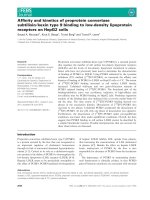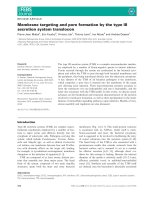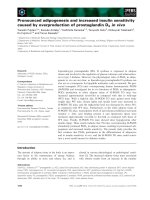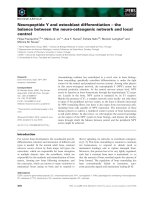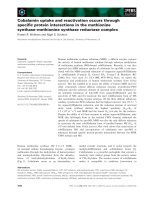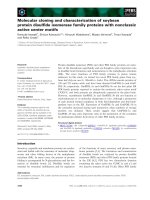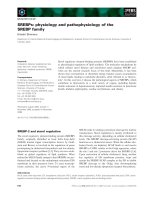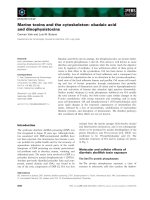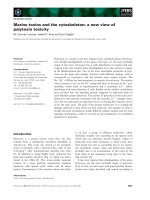Báo cáo khoa học: "Robust Generic and Query-based Summarisation" pdf
Bạn đang xem bản rút gọn của tài liệu. Xem và tải ngay bản đầy đủ của tài liệu tại đây (412.59 KB, 4 trang )
Robust Generic and Query-based Summarisation
Horacio Saggion
Kalina Bontcheva
Hamish Cunningham
Department of Computer Science
University of Sheffield
211 Portobello Street - Sheffield - Si 4DP
England - United Kingdom
fsaggion, kalina, ac.uk
Abstract
We present a robust summarisation sys-
tem developed within the GATE archi-
tecture that makes use of robust compo-
nents for semantic tagging and corefer-
ence resolution provided by GATE. Our
system combines GATE components with
well established statistical techniques de-
veloped for the purpose of text summari-
sation research. The system supports
"generic" and query-based summarisation
addressing the need for user adaptation.
1 Introduction
Two approaches are generally considered in au-
tomatic text summarisation research: the shallow
sentence extraction approach and the deep, un-
derstand and generate approach (Mani, 2000).
Sentence extraction methods are quite robust, but
sentence extracts suffer from lack of cohesion and
coherence. Methods that identify the essential
information of the document by either information
extraction or text understanding and that use the
key information to produce a new text, lead to
high-quality summarisation (Paice and Jones,
1993; Saggion and Lapalme, 2002) but suffer
from the knowledge-bottleneck problem: adapting
information extraction rules, templates, and gen-
eration grammars to new tasks or domains is time
consuming. An alternative to these approaches is to
use combination of robust techniques for semantic
tagging together with statistical methods (Saggion,
2002).
Here, we present a summarisation system that
makes use of robust components for semantic tag-
ging and coreference resolution provided by GATE
(Cunningham et al., 2002). Our system combines
GATE components with well established statistical
techniques developed for the purpose of text sum-
marisation. The result is the sentence extraction
system shown in Figure 1, the relevant sentences
of the document are highlighted in the GATE user
interface. The figure also shows semantic informa-
tion identified within the document (e.g., named en-
tities). All summarisation components developed as
part of this research are made available as a Java Li-
brary for research purposes
1
.
2 The Summariser
Our system is a pipeline of linguistic and statisti-
cal components. Some of them are based on AN-
NIE, a free IE system available as part of GATE
2
. A
number of components have been developed for the
purpose of this research and they make use of the
information produced by ANNIE. These modules
can be coupled and decoupled to produce different
summarisation configurations. The system supports
"generic" and query-based summarisation address-
ing the need for user adaptation.
The input to the process is a document, a compres-
sion rate, and a query (optional). The document is
automatically transformed by a text structure anal-
yser into a GATE document: a structure containing
the "text" of the original input and a number of an-
notation sets. Each component in the pipeline adds
new information to the document in the form of new
'The summarisation components can be obtained by con-
tacting Horacio Saggion .
uk/
-
saggion.
2
http: //gate.ac.uk/.
235
0
Mrtences,etbr
•
Original markups annotations
CONPUD
I
•
DOCUMENT
ANALYSER'
LHCEC
UDLEGCLCEEAIRC (LAW)
LABOR. UIJONS, STRIKES. WAGES, REC,ITMENT (I.A8)
LAW .4 LEGAL ISSUES
ANID
LEGISLATION (LAW)
INAIVAGEINENT ISSUES 0.1147)
NEN
,
JERSEY,.
NOIR,
AMERICA
(D.4E)
UNITED STATES
0J6,
our
reise) hos truss,
a
worm, for the
same
inree
months
"
cM1110-cate leave that .e-
herself
M1. received
a few
ire
'
earlier
d
no
He
aorearegle
ner
bum
He
Said
No
•
fa
S.1.1, IS
noN11.111,
CO "
M.O.;
Fee Ile
Freels, view laterowefor arien elee.lere
"11
wars
n
unwritten rule that
lea,
was at a manager, rAserelon
a.
it
11.1
argils.
men
.
.
Duc-,
I
TECH-2
I
TEcn
-
11
Cate
▪
Arecilications
-
•
DOCUMENT
•
SLMMACCER.
A
NE
T
A
TECH-2
TA TECH-I
in
CORK,
▪
a
Proc s,.r.
Resourcer
Es TEEN FREQUENCY
STATKTIC CONE
kg
SENTENCE COO.
POSITION
Otenen Tod Hein
Figure 1
.
Summarisation results
annotations or document features. Some summari-
sation components compute numerical features for
the purpose of sentence scoring. These features are
linearly combined in order to produce the sentence
final score.
2.1 General Purpose Components
These general purpose components are part of the
ANNIE system, distributed with GATE:
•
Unicode tokeniser: splits text into simple to-
kens, such as numbers, punctuation, symbols,
and words of different types (e.g. with an ini-
tial capital, all upper case);
•
Sentence splitter that identifies sentence
boundaries;
•
Gazetteer lookup that identifies and classifies
key words related to particular entity types and
help in the process of named entity recognition;
•
Named entity recogniser that identifies and
classifies more complex sequences of tokens in
the source document. We use JAPE (Java An-
notation Pattern Engine), a pattern-matching
engine implemented in Java, to identify entities
of type person, location, organisation, money,
date, percentage, and address. For other se-
mantic categories in particular domains, spe-
cific grammar rules can be developed.
•
Part-of-speech tagging is done with an imple-
mentation of the "independence and commit-
ment" learning approach to POS tagging;
•
Morphological analyser (this module is not
part of the GATE distribution), is a rule-based
lemmatiser that produces an affix and root for
each noun and verb in the input text.
•
Coreference resolution, it is a light-weight,
corpus-based approach for the resolution of
named entities anaphora in text.
2.2 Summarisation Components and Scoring
These modules have been developed for the purpose
of summarisation research and are made available as
a library of Java classes and configuration file (i.e.
creole in GATE terminology):
•
Corpus statistics: token statistics including to-
ken frequency and lemma (or root) frequency
are computed in this step.
•
Vector space model (Salton, 1988): is used to
create a vector representation of different text
units. Each vector contains the tokens of the
text unit and the value
token frequency * in-
verted document frequency. Inverted document
frequencies (i.e., distribution of tokens in a big
collection) for English is computed using the
British National Corpus (this information is a
parameter of the summariser making possible
to experiment with frequencies from different
236
corpora). Vector representations are produced
for : (a) the whole document, (b) the lead-part
of the document (the n% initial tokens of the
document, where n is given as a parameter),
and (c) each sentence.
•
Term frequency: this module computes the
value
E
t f * idf
for each sentence in the doc-
ument. The sum is taken over the sentence to-
kens and normalised by the maximum term fre-
quency over all sentences.
•
Content-based analysis: this module computes
the similarity between two text units by com-
puting the
cosine
between their vector repre-
sentations (other similarity metrics will be in-
corporated in the future). We perform the fol-
lowing computations:
similarity between each sentence and the
whole document;
similarity between each sentence and the
lead-part of the document;
similarity between each sentence and its
previous sentence (similarity forward);
similarity between each sentence and its
following sentence (similarity backwards);
The similarities forward and backward are
combined in a single numeric value represent-
ing how "cohesive" the sentence is to the previ-
ous and following text. We identify sentences
that: (a) begin segments (they are dissimilar
with the previous sentence but similar to the
following sentence); (b) are in the middle of
a segment (are similar to both previous and
following sentences); (c) close segments (they
are similar to the previous sentence but not to
the following sentence); or (d) have no relation
with previous or following sentences.
•
Named entity statistics module: based on the
output of the coreference module we compute
coreference classes grouping together all men-
tions of the same named entity (e.g., "Bill Clin-
ton" and "Mr. Clinton" belong to the same
class). For each coreference class we iden-
tify its size and frequency
(ne_f req),
the sen-
tence containing the first mention of an ele-
ment in the coreference class, and the
inverted
NE frequency
(or i _ne_f req)
(e.g., the ratio of
the number of sentences / the number of sen-
tences containing an element of the corefer-
ence class).
•
Named entity scorer. This module performs the
following computations:
first mention of a named entity: sentences
containing the first mention of a class with
more than one instance receive a bonus;
named entity density: is the ratio of the
number of coreference classes in the sentences
to the number of coreference classes in the text;
in a way similar to the content based anal-
ysis of sentences, we measure the cohesiveness
of sentences; based on the links named entities
have in the text (e.g., forward and backward
links);
in a way similar to the term distribu-
tion scorer, we compute a composite value
representing the distribution of the corefer-
ence classes in the sentence (E
ne_f req *
i_ne_f req),
this value is normalised by the
maximum value obtained for all sentences.
•
Sentence position: for each sentence two val-
ues are computed. Absolute position: sentence
i receives the value i
1
. Relative position: if
the sentence is at the beginning of a paragraph,
this value is set to
initial,
if the sentence is at
the end of the paragraph (for paragraphs with
more than one sentence), this value is set to
fi-
nal,
if the sentence is in the middle of the para-
graph (for paragraphs with more than two sen-
tences), this value is set to
middle.
These three
values are parameters of the sentence position
scorer.
•
Query-based scorer: a query (e.g., string) can
be specified as parameter to the summarisation
process in order to boost the value of sentences
which 'content' is close to the query 'content'.
The query is analysed and a vector represen-
tation is produced for it. A similarity value
is computed between each sentence and the
query.
237
The final score for a sentence is computed using
the following formula:
Er
i
L
i
value( f eaturei) * weighti
where the weights are obtained experimentally
and constitute parameters of the summarisation pro-
cess (the summariser comes with pre established
weights that can be modified by the user). The
scores are used to produce a ranked list of sentences.
Sentences on the ranked list are included in the sum-
mary until the compression rate is reached. A mod-
ule is also available that allows the user to spec-
ify "text units", section headings for example, that
should be excluded from the ranked list. The anno-
tations can be used to produce a stand-alone version
of the summary.
3 Evaluation
Evaluation is an essential step of any natural lan-
guage processing task. However, many research
projects make use of in-house evaluation, making
it difficult to replicate experiments, to compare re-
sults, or to use evaluation data for training purposes.
When text summarisation systems are evaluated by
comparing extracted sentences to a set of "correct"
extracted sentences, then co-selection is measured
by precision, recall and F-score. Gate's Annota-
tionDiff tool enables two sets of annotations on a
document to be quantitative compared (i,e. two
summaries produced by two summarisation con-
figurations). We are making use of human anno-
tated corpus (source documents and sets of extracts)
(Saggion et al., 2002b) in order to evaluate dif-
ferent system configurations and to identify exper-
imentally the best feature combination. Process-
ing resources for content-based evaluation have al-
ready been integrated in the system (Pastra and Sag-
gion, 2003). Future work will include the use of
document-summary (non extractive) pairs (from the
Document Understanding Conferences Corpus as
well as from the HKNews Corpus (Saggion et al.,
2002a)) and machine learning algorithms to obtain
the best combination of the summarisation features,
where 'extracts' will be learn based on the automatic
alignment between the non-extractive summaries
and their source documents. The summarisation
system presented here provides a framework for ex-
perimentation in text summarisation research. The
summariser combines two orthogonal approaches in
a simple way taking advantage of robust techniques
for semantic tagging, coreference resolution, and
statistical analysis. Our work in progress is also
looking at the automatic acquisition of 'cue phases'
from corpora in order to implement the indicator
phrases method. Future versions of this system will
contain multi-document and multi-lingual summari-
sation components.
References
Cunningham, H., Maynard, D., Bontcheva, K., and
Tablan, V. (2002). GATE: A framework and graph-
ical development environment for robust NLP tools
and applications. In
ACL 2002.
Mani, I. (2000).
Automatic Text Summarization.
John
Benjamins Publishing Company.
Paice, C. D. and Jones, P. A. (1993). The Identification
of Important Concepts in Highly Structured Technical
Papers. In Korfhage, R., Rasmussen, E., and Willett,
P., editors, Proc. of the 16th ACM-SIGIR Conference,
pages 69-78.
Pastra, K. and Saggion, H. (2003). Colouring sum-
maries Bleu. In
Proceedings of Evaluation Initiatives
in Natural Language Processing,
Budapest, Hungary.
EACL.
Saggion, H. (2002). Shallow-based Robust Summariza-
tion. in
Automatic Summarization: Solutions and Per-
spectives,
ATALA.
Saggion, H. and Lapalme, G. (2002). Generat-
ing Indicative-Informative Summaries with SumUM.
Computational Linguistics.
Saggion, H., Radev, D., Teufel, S., and Lam, W. (2002a).
Meta-evaluation of Summaries in a Cross-lingual En-
vironment using Content-based Metrics. In
Proceed-
ings of COLING 2002,
pages 849-855, Taipei, taiwan.
Saggion, H., Radev, D., Teufel, S., Wai, L., and Strassel,
S. (2002b). Developing Infrastructure for the Eval-
uation of Single and Multi-document Summarization
Systems in a Cross-lingual Environment. In
LREC
2002,
pages 747-754, Las Palmas, Gran Canaria,
Spain.
Salton, G. (1988).
Automatic Text Processing.
Addison-
Wesley Publishing Company.
238
